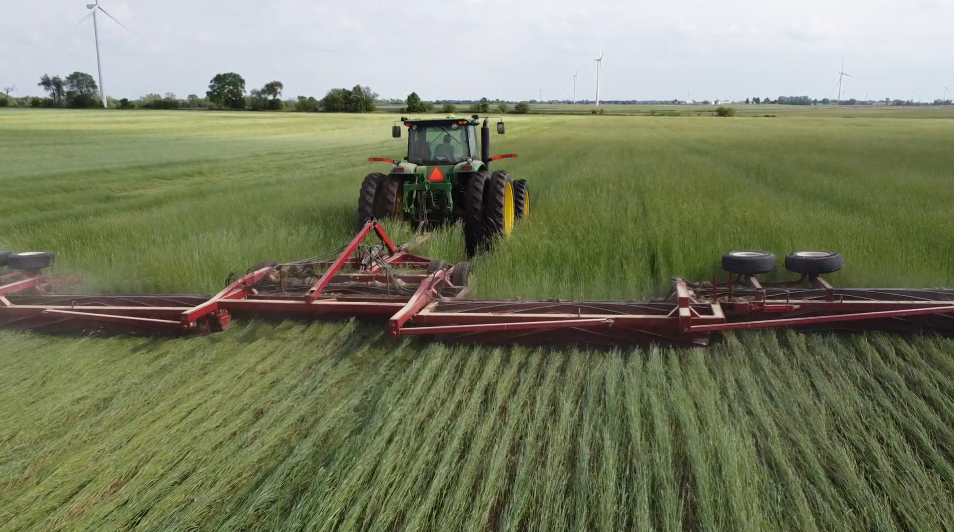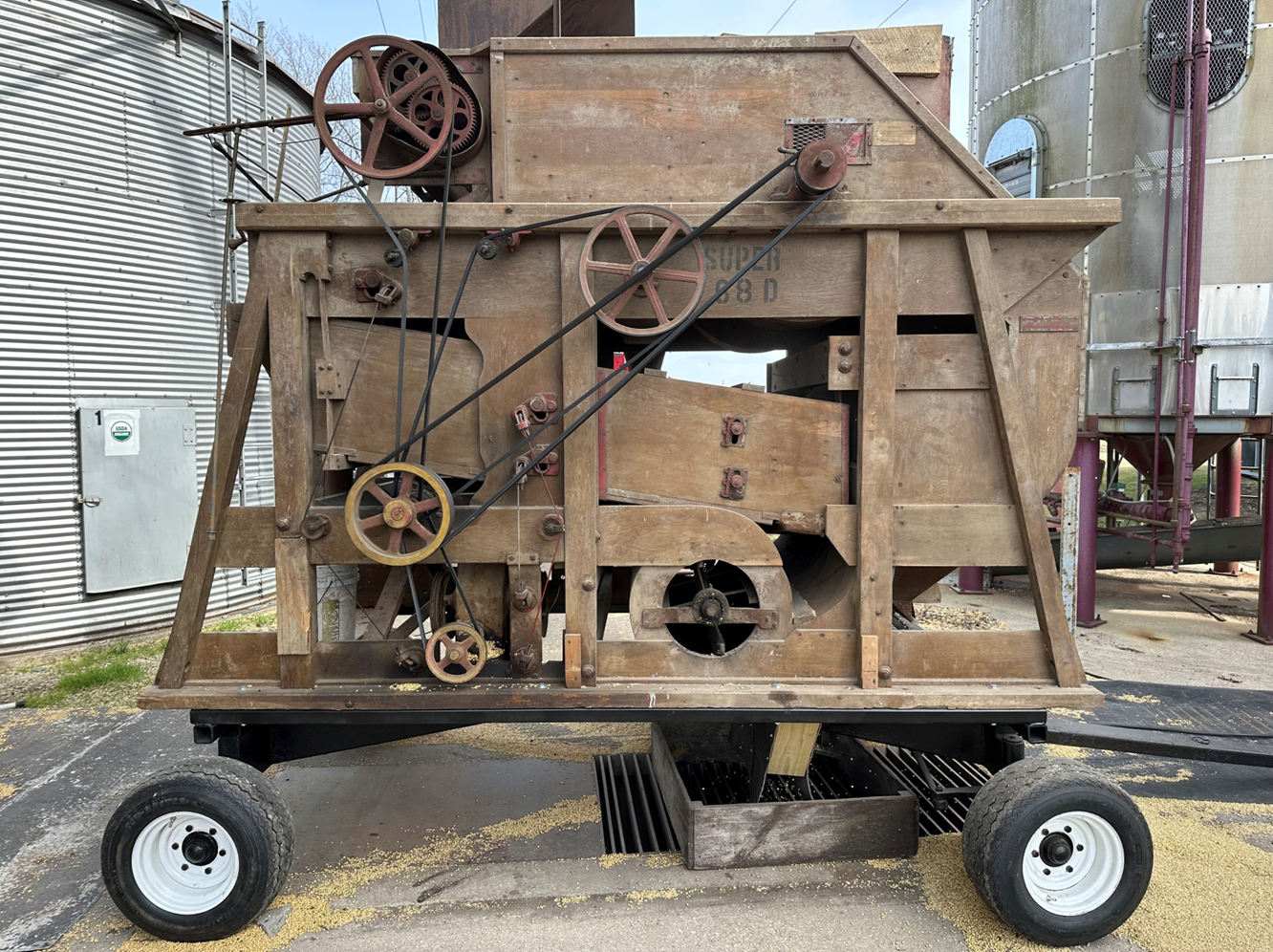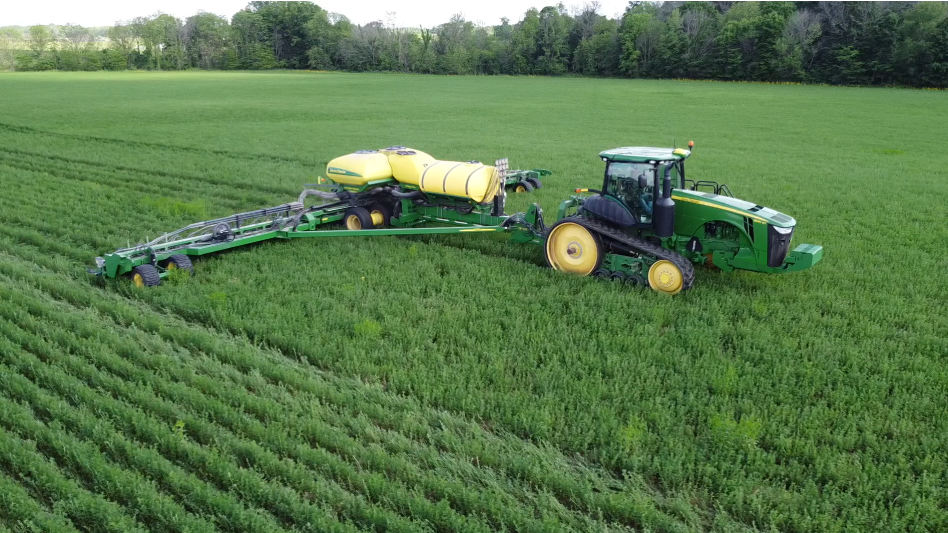No-Till Innovator Rick Clark of Williamsport, Ind., says diversity is his top consideration in building soil health. His farm fields have 9 different crops growing throughout the year.
“Everything is about diversity — diversity of cover crop cocktails and cash crop rotations,” Clark says. “It’s almost as big a sin to plant straight cereal rye as it is to plant straight corn or beans. Whenever we’ve got an opportunity, we have to get diversity in with the cover crop.”
Clark’s operation is certified organic and no-till, and he’s working toward a three-pass system. Before the organic certification, he built a program to reduce inputs.
“We were 100% no-till, 100% cover crop, 100% non-GMO and 70% reduction of inputs,” Clark says. “We were still using some chemistry and fertility, and we had the best ROI the farm’s ever seen.”
Switching to organic taught Clark an important lesson about markets.
“When I was non-GMO, for the most part, the markets were within 30-40 miles,” Clark says, “but now that I’m organic, beans are hauled 8 hours one way. Corn goes 7 hours another way. We’ve had to go into Texas with our milo. Always be looking for your market.”
Covers as Weed Control
Biomass is critical when using cover crops to prevent weeds in soybeans, according to Clark.
“You’ve got to have upwards of 10,000 pounds of biomass to suppress weeds,” Clark says.
Clark says that the timing of planting cover crops makes a huge difference in weed prevention. For example, one field had a cover crop planted in the first week of September, and on July 16 of the following year, there were no weeds. But a field five miles down the road with cover crops planted the last week of November “looked like a train wreck” with the amount of weeds in it.
“We may not think about the timing in the fall, but I’m telling you as every day goes by, your biomass next spring is going down,” Clark says.
He uses a John Deere air seeder with 7½ -inch row spacing to plant cover crops September 1 . Clark plants tillage radishes, clover, cowpeas, sunn hemp, sunflowers as his cover crop mix, emphasizing species that will winterkill and also control weeds. He keeps an inventory of each seed and blends his own mixes.
Cover crops provide most of the weed control in Clark’s field. He says last year, he spent no money on chemistry before July 19.
“There’s no burndown, no post spray, no nothing,” Clark says.
Foxtail and marestail appeared in the fields late in the summer, but Clark wasn’t concerned.
“Now, if you don’t want to be organic — and I totally understand that — and you still want to maintain fairly clean fields, you can go in with a post spray to keep it under control, and you’ve still reduced your chemical load by at least 50%,” Clark says.
Soybean Program
Clark had been using a cereal rye cover crop for soybeans and no-tilled soybeans into boot stage rye toward the end of April.

No-Till Innovator Rick Clark of Williamsport, Ind., uses a roller crimper to roll down rye when soybeans reach stage V1.5 to V2. The vegetative mat will suppress weeds until the soybean canopy develops.
“The rye sequestered the nutrients that little weeds needed to survive,” Clark says. “As the rye grew and canopied, it crushed those weeds.”
The rye was sometimes rolled down before planting soybeans. In 2019, Clark couldn’t get in the field until June 2 due to rampant rains. The rye was 6 feet tall, and it lodged.
“The rye was already anthesis, so we decided to roll the rye first before planting soybeans,” Clark says.
For the last 2 years, he’s planted soybeans into maslin, a 3-4-way cereal grain mix. Clark uses wheat, rye and barley.
“They’re mixed together, and then you plant into those,” Clark says. “We don’t roller crimp it, and we let it grow. We harvest the beans and the maslin together, and then we separate them. We have two crops growing in the field at the same time.”
Clark says he likes the synergy between the maslin and soybeans. With the help of what he calls his “Dave Brandt cleaner,” which came from the late No-Till Legend, Clark can harvest four crops at the same time and then separate them.

The Clipper cleaner separates soybeans from maslin, creating food-quality grains. Clark refers to it as his “Dave Brandt,” since the Brandt family in Ohio provided the cleaner.
“In 1 pass through that machine, it’s food-grade quality,” Clark says. “You’ve got this hodgepodge of soybeans, rye, barley and wheat going in, and coming out is solid soybeans on one side, and the maslin, wheat seed and everything else coming out over here.”
At harvest, the combine is set for minimum damage to the soybeans.
“We could set the combine tight and get it clean in the field, but we’d have splits out the rear end,” Clark says. “So, we back all that off, and we try to gather more cereal grain with our sample and get to where it’s 5% splits or less. Then we let the cleaner do the rest of the work.”
Clark says co-mingling cash crops is the future of no-till.
“Corn and fava beans would work great together,” Clark says. “I think beans and milo would work. We’re doing beans and wheat. We’re doing peas and wheat. We can figure out how to do all of these things.”
Corn Experiments
As if organic no-till wasn’t challenging enough, Clark continues to experiment with his cropping system. For four years, he no-tilled corn into standing alfalfa, which he emphasizes is risky.
“You need corn with good vigor to handle this challenge,” Clark says. “You’ve got an established perennial of alfalfa, and you’re trying to plant an annual warm grass of corn into that.”
During the corn’s V2 stage, Clark rolls the alfalfa to give the corn a chance to collect sunlight.
“Corn does not like competition,” Clark says.
Clark says the alfalfa helps suppress weeds — but not in the same way as his cover crops.
“70% of weed suppression is coming from the cover crop you plant. The other 30% is coming from the cash crop canopy,” Clark says. “The same thing’s happening here, but in reverse. When we harvested this field, there was no alfalfa left. The 20-inch row spacing corn canopied and crushed the alfalfa.”
He says the process of planting alfalfa before corn is more difficult than it looks and advises trying it on 1-2 acres first before committing to it.
“I am hopeful of this system for corn production,” Clark says.

Clark plants no-till corn into alfalfa during the second pass of his three-pass system. He says this is a risky venture, but he encourages farmers to try the alfalfa and corn combination on a couple of acres.
Sheep and cattle grazing on crop fields have benefited the land as well.
“The crops that are grown the year after a field was grazed by livestock are the best crops we have on the farm,” Clark says. “That’s not a very scientific test, but it’s a realistic test that tells me the cattle and sheep are very good at building soil health quickly and efficiently.”
Clark limits grazing cattle on ground with corn in the next rotation.
“Corn does not like compaction,” Clark says. “I would not bring corn right behind cattle. I’m going to bring wheat, soybeans or maybe another cover crop, and then let that compaction work its way out until I come back with corn.”
Future of No-Till Technology
As he looks to the future, Clark says technology, as well as fundamentals like water quality and biology, will become increasingly important.
Global Neighbor stands out to Clark as a promising agtech company. Jon Jackson, president of Global Neighbor, and his team are studying the light spectrum to understand what part of the light spectrum kills weeds and what part promotes germination.
“He’s got a light bar you put in the back of your combine, right behind the straw walker,” Clark says. “Every weed seed that you’ve harvested out in front is coming out the back end. It’s going underneath this light set for killing weeds, and it’s now sterile seed. Weed seed coming out the back end is no longer viable to grow.”
Robots from Greenfield Incorporated are another versatile tool for the field.
“They can plant cover crops, they can spray chemicals, and they could spray biology,” Clark says. “They work 24/7, and they don’t complain about anything.”
The company Pursanova uses a process to lower the surface tension of water, making it easily absorbed, and reverse osmosis systems for water coming out of a center pivot that puts out 1,400 gallons per minute. Clark says water quality is important for all applications.
“No matter what it is you are spraying on your fields, you need good water,” Clark says. “If you’ve got high pH, low pH, high calcium, high sulfur, high sodium, whatever, you are going to affect whatever you’re dumping in your tank.”
Clark also emphasizes the need for healthy soil biology, especially when beginning to build a soil health system.
“I was very stubborn about biology at the beginning,” Clark says. “When you’re in the transition and you’re coming out of mass destruction to the soil where there is very little biology, get a biological program running with you side-by-side through your regenerative system.”
Clark says to make sure any purchased biological products come from a trusted company. He’s considering biochemistry products to address weeds, rye and thistle in his fields. He plans to go down the middle of the row with a hooded sprayer to prevent crop damage.
“On our farm, with the combination of 10 years of no-till with 10 years of no chemistry, we’re getting volunteer everything growing out there,” Clark says. “I need to reset, so we’re going to try some of these products.”
Another aspect of no-till’s future is epigenetics, changes in phenotypic traits that occur from adapting to the environment or through normal development. It’s an idea rooted in the past, according to Clark, who recalls collecting seed beans with his father after harvesting their fields. Clark’s father said they collected the seeds rather than buying seed from a dealer because the beans were adapted to their system.
To find the best soybean varieties for his operation today, Clark purchased 25-year-old soybean genetics from the USDA’s seed catalog and hand-planted 10 varieties. Then, he harvested the soybeans by hand. After hand-planting and hand-harvesting, he was able to plant 60 acres of soybeans with a planter in the fourth year. Based on his observations, he whittled 10 varieties down to 5.
When he wasn’t able to separate the five varieties into separate bins, Clark decided to “let the beans decide through epigenetics which is going to be best for the farm.”
“They’re all five put together,” Clark says. “You go out and you plant them on the farm. You pull in and you get seed out of this field right here. It’s a co-mingling of all these, and you let it decide what it’s going to be.”
Related Content
[Podcast] Regenerative Organic No-Till with Rick Clark
Rolling Covers, Planting Non-GMOs ‘Green’ Leads to Efficient, Thriving No-Till System
Cover Crop Nutrients Keep Money in No-Tiller Pockets






